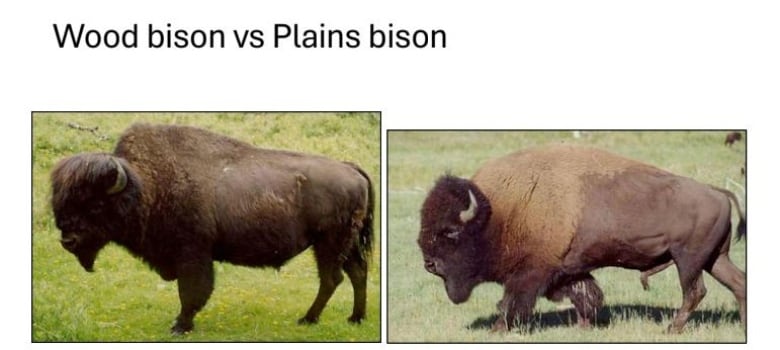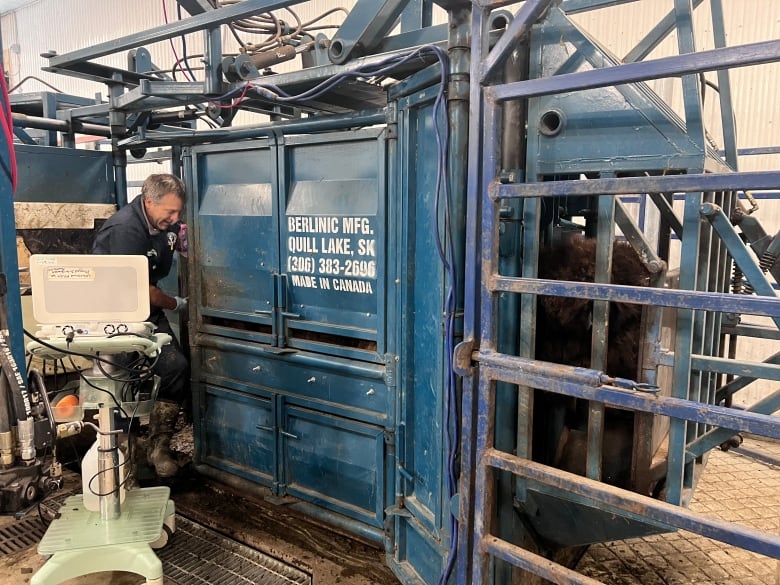Gene project to help wood and plains bison underway in Sask.
Research group interested in working with First Nations bison herds

Researchers at the University of Saskatchewan are working on a bison genome bank,to help restoregenetic diversity in herds and keep the two subspecies distinct.
Gregg Adams, a professor at the Western College of Veterinary Medicine, said his research group aims to introduce new genetic linesinto conservation bison herds, like some of those managed by First Nations in Saskatchewan.
"A lot of our conservation herds are deprived of new genetics and so the gene pool is not as deep as we want it to be and it needs to be," he said.
Adams saidresearchers have been working on this for over a decade and have seen success.They've collected genomes from bison herds across North America to introduce more diversity into herds that would otherwise never cross paths.
In the 1920s, the Government of Canadamixed plains and wood bison at Wood Buffalo National Park, on the N.W.T./Alberta border.Today many herds are hybridsof plains and wood bison.
Currently, the research group is working with Wood Buffalo National Park and Elk Island National Park bison at the Native Hoofstock Centre near Saskatoon.
They are working to synchronize the bison's ovulation patternsto ensure insemination is successful. They are also matching female wood bison with male woodbison semen to eliminate hybridization, and doing the same with plains bison.
The research group wasin contact with First Nations groups in Albertaand is interested in working with more First Nations in Saskatchewan.
Zagime Anishinabek First Nation, about 150 kilometres east of Regina, got a herdofhybrid bison in 2020 and a second herd of plains bison from Grasslands National Park in 2022.
Chief Lynne Acoose said her community isn't involved in the college's research project yet, but that she thinks restoring the genetics of the animals is important.
"Plains bison have their own purpose in the plains region," she said.
"They contribute to the balance of the ecosystem. I think they play a very important role in restoring the health of the prairie ecosystem."

She said the same goes for the wood bison and their original habitats.
"It's part of our obligation to the buffalo to try to maintain and contribute to the restoration of the buffalo in their natural habitats because they sustained our people for millennia. So that's our way to give back to buffalo."
Muscowpetung First Nation, about60kilometres northeast of Regina,got its herd of woodbison in 2020. Trent Benjoehas worked with the herd for two years.
He said he's aware of the research projectand he's interested in their workbut wants to see more results from the project before he commits to participating.
Benjoe said his herd has seven bulls and he's looking for more female wood bison for them to mate with but they need to go through genetic and veterinary testing to screen for diseases.

Adams said he doesn't know just how manypure woodbison are left on Earth, as most are now genetically mixed.
"Now doesn't mean that we've lost them all," he said.
"We know that several of the herds have a very minor proportion of their genetic makeup as a mix. So we can work our way back to essentially a pure wood bison."
Benjoe said before he'd heard of the college's study, he knew of Indigenous bison herders who were already working to keep their bison lineage hybrid-free, which he says is an important aspect of raising the animals.
"I want to be remembered for this, looking after these bison," he said.
"Those bison took care of us by clothing us, feeding us, and everything else. They're spiritual animals. So I think it is right that we do this for them."












_(720p).jpg)


 OFFICIAL HD MUSIC VIDEO.jpg)
.jpg)



























































































